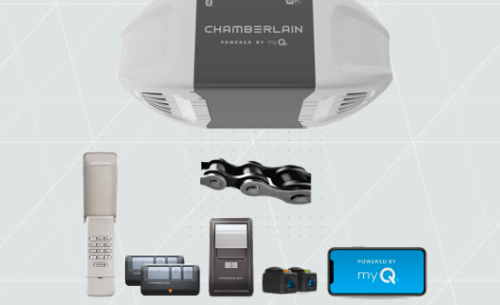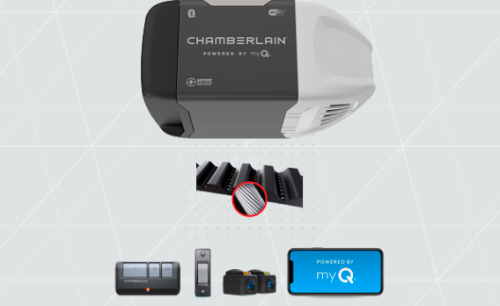Choosing the right garage door opener shouldn’t be a difficult process if you know what you need and want. Garage door openers from reliable manufacturers are made of resilient materials and reliable internal mechanisms. With so many options out there, you need to choose a door opener that works for years or even decades with minimum issues. What is the difference between a chain vs belt garage door opener?
The primary difference between chain and belt drive garage door openers is the type of power transmission mechanism used to move the door. Chain drive openers use a metal chain to drive the trolley that pulls the door open and closed. Belt drive openers use a rubber belt for power transmission. Chain drive openers tend to be noisier and more affordable, while belt drive openers are quieter and more expensive.
It is recommended to get more familiarized with different designs of garage door openers. The more you understand the technology behind these garage openers, the more likely you will find the one you need. If your garage door lacks any powered mechanism, here are the benefits of installing one:
- Better security: Garage door openers can be integrated with the smart home network for automatic opening and closing. A timer is a standard feature of many garage opener models, so it will close automatically without your intervention. Often, you keep expensive items inside the garage, such as an electric moped, lawnmower, leaf blower, generator set, and vacuum cleaner. People can steal those items easily if you leave the door open for too long.
- More convenient: Garage door openers ensure convenience and ease of control. It usually comes with a remote controller that you can put inside the car, so you can open the garage door without getting out of the car. Elderly people don’t need to wear themselves out to manually open the garage door, especially if it’s wide and heavy.
- Extra lighting: Many garage door models have built-in lighting feature that provides adequate illumination when you open the door at night. Some door openers have a backup battery, so the LED light will still turn on during bad weather or a blackout.
- Prevent injuries: Garage doors with simple, manual mechanisms may crash down suddenly, hitting children, pets, or cars. On the other hand, chain- and belt-driven doors will close slowly, giving more time for children and pets to move away safely.
- Energy-efficient: Despite being electrically powered, chain- and belt-driven garage door openers consume very little energy, so you will barely see any difference in your monthly electric bills. You may spend less than $10 annually on electricity after installing a powered garage door opener.
- Better temperature control: Heat may escape easily if you leave the garage door open for an extended duration, especially during winter. If winter in your area is cold and snowy, you may look for a garage door opener with a built-in temperature sensor to alert you when it gets very cold inside the garage. This should help in improving comfort and energy efficiency in your home.
- Easy integration with the smart home network: Electrically-powered garage door openers can be easily integrated with the smart home network if it has a digital interface to receive and transmit data. This means you can control the garage door remotely with your smartphone, regardless of where you are. Combined with a live CCTV feed, you may allow the delivery guy to put the package inside the garage door with your smartphone.
- Increase home’s value: A good upgrade should increase the value of the house substantially and a good way is to replace the manual mechanism of your garage door. A chain- or belt-driven garage door opener can work automatically, which increases the value of your home. Potential buyers prefer convenience and the absence of an automatic garage door opener can be a deal-breaker.
If you already have installed a garage door opener years ago, you may consider replacing it if:
- It’s getting noisy: Wear and tear may cause the garage door opener to run roughly and sluggishly. A worn-out mechanism may generate plenty of noise when the door is closed or opened. A new garage door opener will operate reliably without generating loud noises.
- It’s malfunctioning: It’s probably time to replace your old garage door opener if it’s no longer working as safely or efficiently. Despite regular maintenance and careful usage, every mechanism will start to wear out and fail. If not properly cared for, the lifespan of your garage door opener can be much shorter than expected.
If you are in need of a new opener for your garage door, it’s important to know what mechanism to choose. Most garage door openers have a chain or belt-driven system and they are relatively easy to understand.
Comparison Chain vs Belt drive door opener
Let’s face it, garage door openers can be challenging to understand. There are many brands, styles, and types out there. It’s hard to choose such a vital piece of equipment for your garage without a lot of help. To make your decision easier here is a comprehensive comparison between belt drive vs chain drive door openers.
Chain drive garage door openers are typically the most economical option, but they are also the loudest. Belt drive garage door openers are quieter and more expensive, but they are also more durable. Chain drive openers are more suitable for lighter garage doors, while belt drive openers are better suited for heavier doors.
Chain-Driven Garage Door Opener

Many garage door openers in the market have chain-driven mechanisms, which use a chain that looks like the one that you would find on a bicycle. The mechanism has a J-arm and carriage that allows the door to move up and down. Due to their simplicity, chain-driven garage door openers are generally affordable, which is a worthwhile investment for any homeowner.
Due to its popularity, chain-driven models are found everywhere and most of your neighbors may have a similar garage door opener mechanism. If you are wondering how this technology works, you may ask the neighbor to see their garage doors in action. Local repair professionals usually have the skill and experience to provide maintenance and repairs for chain-driven garage door openers.
Belt-Driven Garage Door Opener

Belt-driven garage door openers are largely identical to their chain-driven counterpart. Whereas the chain-driven model uses a chain to operate the whole mechanism, the belt-driven one moves the trolley with a rubber belt. To ensure longevity and reliability, the rubber is usually steel-reinforced. But instead of rubber, you may also find models with fiberglass or polyurethane belt.
The advantage of a belt-driven mechanism is quite obvious. Garage door openers with this belt-driven mechanism have smoother operations. The overall level of noise is significantly lower, due to the absence of metal-on-metal friction. There will be less need for lubrication and the mechanism should be equally reliable. However, the overall cost of installing a belt-driven garage door opener is usually slightly higher. Even so, many homeowners wouldn’t hesitate to invest a little more of their money for a quieter operation.
Chain-driven garage door opener: Pros and Cons
Pros
- More strength: Although steel-reinforced belts are reasonably adequate for most tasks, you need a chain-driven mechanism for real heavy lifting. If you have a heavy wooden door, a chain-driven mechanism is more suitable with additional strength and better reliability. A belt-driven mechanism may struggle to operate heavy garage doors and this has an impact on the reliability of the mechanism.
- Longevity: Because it’s made entirely of metal, chains will certainly last longer than any steel-reinforced belt. Assuming that you continue to lubricate it, the chain may remain operational for many years to come. After prolonged use, you may see signs of wear and tear on belts.
- Weather-resistant: Chain-driven mechanism should work well in any weather. You will have no concerns about extremely low temperatures and high humidity levels in your area. Exposure to very low temperatures may cause the belt to become slightly brittle, accelerating its wear and tear during winter.
- Lower costs: If you prefer a more cost-effective solution, you should consider choosing a chain-driven system for your garage door opener.
Cons
- Noisy: If you can’t handle louder noise, a chain-driven mechanism may not be the one for you. It could be a constant annoyance if the mechanism is overly loud each time you open and close the door. Constant contact between metal components creates loud friction, which is quite bothersome if your garage is close to the bedroom or any lounging space. But with enough lubrication, you may ensure a quieter operation and some newer chain-driven models are noticeably quieter than older ones.
- Clunkier: Chain-driven mechanism will never be as smooth as a belt-driven one. The closing and opening operations of chain-driven models are also usually slower.
- More maintenance: You need to lubricate the chain-driven mechanisms more often to prevent corrosion and wear. At a minimum, you need to maintain the chain every six months. This usually involves wiping the chain clean to remove grime and re-lubricating it with fresh oil. Lack of lubrication will make the mechanism runs much slower and noisier.
Belt-driven garage door opener: Pros and Cons
Pros
- Quiet operations: Because you open and close the garage door more than a few times each day, a loud mechanism can be very annoying. This is rarely an issue with a belt-driven garage door opener. Certain models from reputable manufacturers have whisper-quiet operations that won’t cause any noise problems late at night.
- Decent strength: There’s a concern about whether the belt-driven mechanism is strong enough to handle heavy garage doors. In reality, a belt-driven mechanism has been tested and proven to operate any single-door garage.
- Fast response: If you are in a hurry, a responsive mechanism will be less annoying. Although some high-end chain-driven garage door openers work smoothly, you can ensure better response with a belt-driven model.
- Easy replacement: Belts wear out faster than chains, but it’s easy to replace them. A belt has a definite lifespan or you may replace it as soon as you notice serious tearing. It takes fewer tools, less time, and less strength to replace the belt.
- Good availability: Due to its popularity, you may easily find replacement parts for belt-driven mechanisms. Local hardware stores may sell replacement belts or other important components. Online stores should have a complete selection for your garage door opener, regardless of the model.
- Minimum maintenance: Maintaining a belt-driven mechanism is very easy. It takes less lubrication to keep the belt-driven garage door opener running smoothly. However, the belt may stretch out slightly after heavy use and you need to re-apply the right amount of tension to ensure smooth operations.
Cons
- Can’t handle heavy doors: Although the belt-driven mechanism works well for any single-door application, it may be too sluggish for heavier garage doors.
- Less durable: Belt-driven mechanism isn’t suitable in areas with extreme temperature or humidity. The belt may wear out faster, which results in a far shorter lifespan.
- More expensive: If you choose a garage door opener with a belt-drive mechanism, it will set you back more than the chain-driven model.
Which One to Choose?
Deciding on the best and most suitable garage door mechanism depends on multiple factors and your personal requirements. If you have a large garage with a heavy door, it is recommended to choose a chain-driven model for adequate load-bearing capacity. On the other hand, most single-car garages with lightweight doors should do well with a belt-driven mechanism. Even so, make sure that the model has a heavy-duty belt with adequate steel reinforcement.
Look at the budget
If you have a limited budget, a chain-driven garage door opener is preferable, because it’s more affordable than the belt-driven one. Even so, be aware that chain-driven models tend to carry higher maintenance and repair costs. Because the chain-driven mechanism has more metal components, replacement costs of parts will be noticeably higher. Friction will induce more wear and tear, which necessitates the regular replacement of parts. If you choose belt-driven models from reputable makers, they should be worth every penny. But that means you will need to spend more money on the initial investment.
Noise level
Noise level is another major consideration when choosing a garage door opener. Some chain-driven models create a thunderous roar when you open the garage door. Although some chain-driven models are quieter, they are still louder than regular belt-driven models. If you are living in a rural area with no neighbors nearby, a chain-driven opener is suitable, especially if you want to save money initially. But if your garage is adjacent to the bedroom, a belt-driven opener is probably necessary, because it has minimum vibration and noise. Even so, the loud noise of the chain-driven opener can add a layer of security, because intruders will create a racket when they open the garage door.
Convenience
Convenience takes different forms. It could be more strength to operate heavier doors, quieter mechanisms, fewer requirements for maintenance, or lower overall costs. Regardless of the models you choose, it is recommended to choose a garage door opener model with a digital interface for easy integration with your smart home system. This elevates convenience to the next level because you can have more control over how the door should operate. Define your own priorities to decide whether a chain- or belt-driven opener is more suitable for your home.
Another major difference is side mount vs overhead mount garage door openers.
Conclusion – Chain vs Belt drive garage door openers
When deciding between a chain and a belt drive garage door opener, it’s important to consider factors like noise level, installation difficulty, and cost. Chain drive openers are usually louder and tend to be less expensive than belt drive openers, but they are also more difficult to install. Belt drive openers are quieter and easier to install, but they tend to be more expensive. Ultimately, the decision will depend on your budget, personal preference, and the space you have available for installation.
